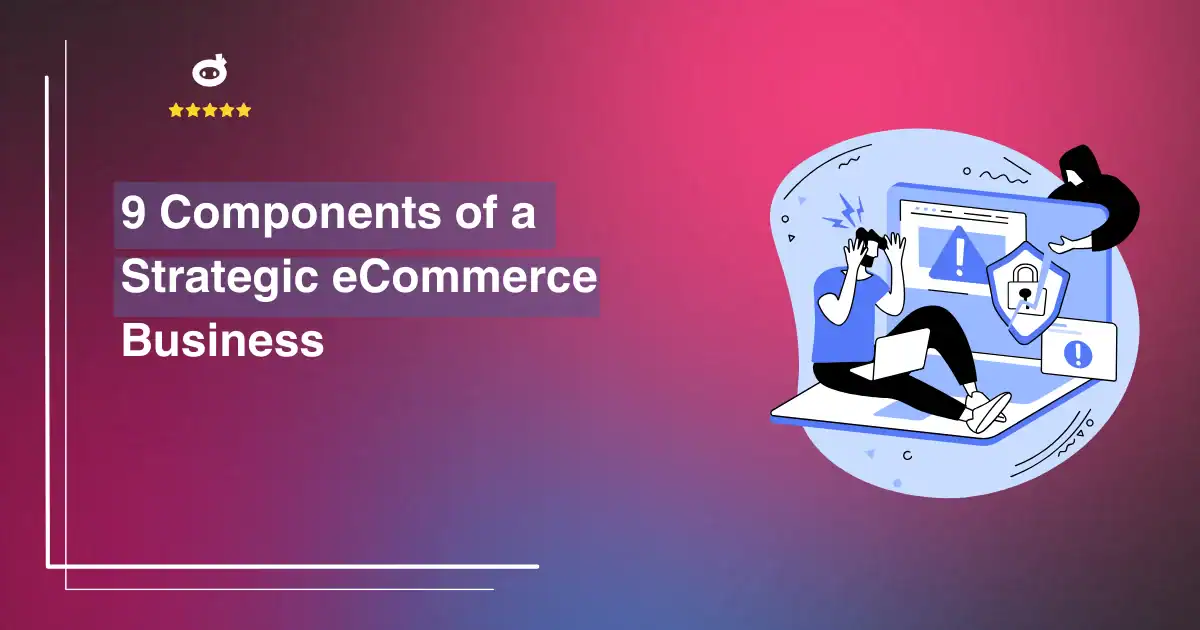What if your business could reach millions of customers worldwide, 24/7, without geographical limits? This is the power of eCommerce. In just a few decades, online shopping has transformed from a convenience into a necessity, reshaping industries and redefining consumer expectations. Businesses that once relied solely on physical stores now thrive in the digital marketplace, leveraging technology to drive sales and engagement.
ECommerce is growing at an unprecedented rate, fueled by mobile accessibility, personalized shopping experiences, and the rise of social commerce. Consumers demand instant gratification, seamless transactions, and brands that connect with them beyond just selling products. With competition intensifying, simply having an online presence is no longer enough.
To succeed, businesses must adopt a strategic approach, one that balances innovation, customer experience, and operational efficiency. From website optimization to marketing and fulfillment, every aspect plays a crucial role in long-term growth.
In this guide, we’ll explore the nine key components that define a thriving eCommerce business. Are you ready to unlock the full potential of your online store? Let’s get started.
Contents
- 1 What is eCommerce?
- 1.1 The Significance of eCommerce in the Digital Age
- 1.2 Key Components of an eCommerce Business
- 1.3 1. Website and User Experience (UX)
- 1.4 2. Product Catalog and Inventory Management
- 1.5 3. Secure Payment Gateway
- 1.6 4. Digital Marketing and SEO
- 1.7 5. Customer Relationship Management (CRM)
- 1.8 6. Logistics and Order Fulfillment
- 1.9 7. Data Analytics and Performance Tracking
- 1.10 8. Mobile Commerce (mCommerce)
- 1.11 9. Compliance and Security
- 2 Types of eCommerce Businesses
- 3 Why eCommerce is So Important Today
- 4 9 Strategies to Increase Your eCommerce Sales
- 4.1 1. Optimize Your Website for a Seamless User Experience
- 4.2 2. Leverage SEO for Organic Traffic
- 4.3 3. Utilize Social Media Marketing
- 4.4 4. Implement Email Marketing Campaigns
- 4.5 5. Offer Multiple and Secure Payment Options
- 4.6 6. Improve Customer Support and Experience
- 4.7 7. Invest in Data-Driven Marketing
- 4.8 8. Leverage Influencer and Affiliate Marketing
- 4.9 9. Enhance Customer Loyalty with Offers and Retargeting
- 5 Reasons to Start an eCommerce Business
- 6 Challenges of Running an eCommerce Business
- 6.1 1. High Competition – Standing Out in a Saturated Market
- 6.2 2. Logistics and Supply Chain Management – Ensuring Smooth Order Fulfillment
- 6.3 3. Cybersecurity Risks – Protecting Customer Data and Transactions
- 6.4 4. Customer Trust and Retention – Building Brand Credibility
- 6.5 5. Constant Adaptation to Market Trends – Keeping Up with Change
- 7 Future Trends in eCommerce
- 8 Conclusion
What is eCommerce?
ECommerce, or electronic commerce, is the buying and selling of goods and services over the internet. It has transformed the global marketplace, allowing businesses to reach customers beyond geographical boundaries. With the rise of mobile technology and digital payment systems, eCommerce has become a key driver of economic growth and business expansion.
The Significance of eCommerce in the Digital Age
In today’s interconnected world, eCommerce is no longer an option but a necessity for businesses. It offers convenience, speed, and accessibility, catering to consumer preferences for online shopping.
From small businesses to multinational corporations, eCommerce enables scalability, enhances customer experience, and provides data-driven insights for business strategies.
Key Components of an eCommerce Business
A successful eCommerce business depends on the seamless integration of several vital components. Each element contributes to a smooth user journey, efficient operations, and sustained growth. Whether you’re launching a new store or improving an existing one, focusing on these pillars will help build a resilient and competitive online business.
1. Website and User Experience (UX)
The website is the foundation of any eCommerce operation. It is where users browse, learn, and make purchases. A smooth and responsive user experience keeps visitors engaged and improves conversion rates.
A well-structured site should offer fast loading times, easy navigation, and clear calls to action. The design must adapt to all devices—desktop, tablet, and mobile. A logical layout with intuitive menus, consistent branding, and secure access points builds trust and helps users move from landing to checkout without obstacles.
2. Product Catalog and Inventory Management
Clear product listings and accurate inventory tracking form the backbone of a good shopping experience. Customers rely on well-presented information to make confident buying decisions.
Your product catalog should feature sharp images, informative titles, and detailed descriptions. Group items into relevant categories to simplify browsing. At the back end, integrate inventory software that updates stock levels in real-time. This prevents overselling and ensures accurate order fulfillment. Auto alerts for low stock and data on best-selling products also support better decision-making.
3. Secure Payment Gateway
A trusted payment system builds customer confidence and reduces cart abandonment. Security and flexibility are top priorities at the checkout stage.
Your site must support multiple payment methods—credit and debit cards, digital wallets like PayPal or Apple Pay, and installment services such as Buy Now, Pay Later (BNPL). Each transaction should be encrypted using SSL certificates, and fraud detection tools should be active to prevent data breaches. Smooth and secure transactions not only protect your customers but also reduce chargebacks and business risk.
4. Digital Marketing and SEO
Visibility drives traffic, and traffic fuels sales. Digital marketing and SEO are necessary to increase reach and attract the right audience to your store.
SEO starts with keyword-rich content, optimized metadata, and clean URLs. Blogs, category pages, and product descriptions must all be optimized for search engines. Alongside organic search, use paid advertising like Google Ads and social media campaigns to drive traffic. Email marketing, influencer partnerships, and retargeting ads help build awareness and keep your brand top of mind.
5. Customer Relationship Management (CRM)
Returning customers are more profitable than new ones. CRM strategies focus on building long-term relationships through consistent, personalized engagement.
Collect and use customer data to tailor product recommendations, offer loyalty rewards, and send relevant emails. Implement live chat, help desks, or ticketing systems to respond quickly to queries. Tools like CRM software let you track customer behavior, preferences, and purchase history, allowing for timely and meaningful outreach that boosts retention and satisfaction.
6. Logistics and Order Fulfillment
Speed, reliability, and clarity in delivery processes are central to customer satisfaction. If your shipping is slow or error-prone, it directly affects reviews and loyalty.
Efficient logistics includes real-time order tracking, streamlined warehousing, and reliable courier partnerships. Offer flexible shipping choices—standard, express, and same-day delivery when possible. Include clear return and refund policies to reduce disputes. Automated systems that print labels, sync inventory, and update customers are essential for smooth fulfillment.
7. Data Analytics and Performance Tracking
Analytics provide insights into what’s working and what’s not. Without data, growth decisions rely on guesswork.
Monitor traffic sources, bounce rates, conversion rates, and average order values. Use tools like Google Analytics, heatmaps, and dashboard software to track sales trends and customer behavior. Data helps identify winning products, bottlenecks in the buying process, and areas for improvement. Regular performance reviews ensure you adapt to user needs and market shifts effectively.
8. Mobile Commerce (mCommerce)
With mobile usage surpassing desktop for online shopping, mobile readiness is not optional—it’s expected. Poor mobile performance results in lost revenue.
Your eCommerce site must be responsive, load quickly on phones, and support one-click payments and autofill. Mobile apps can offer added features like push notifications and saved carts. Simplified navigation, readable text, and accessible menus are essential. A seamless mobile experience ensures that users can browse and buy without frustration, wherever they are.
9. Compliance and Security
Handling user data brings responsibility. eCommerce businesses must meet legal standards for data protection and online safety.
This includes complying with GDPR, CCPA, or other local regulations, and maintaining transparency in how data is collected and used. Install SSL certificates, use strong password policies, and conduct regular security audits. Make privacy policies easy to find and understand. Protecting your site not only prevents breaches but also builds trust with your audience.
By integrating these components strategically, an eCommerce business can thrive in a competitive digital landscape, providing value to customers while driving long-term success.
Types of eCommerce Businesses
E-commerce has transformed the way businesses operate and consumers shop. Different models cater to various needs, connecting businesses and individuals in unique ways. Below are the primary types of eCommerce businesses and their significance.
1. Business to Consumer (B2C)
This model involves businesses selling products or services directly to consumers. It is the most common form of eCommerce, with companies offering everything from apparel to electronics.
Key Features:
- Direct interaction between businesses and consumers.
- Large customer base with high transaction volumes.
- Focus on customer experience and marketing strategies.
Examples:
- Amazon – Offers a vast marketplace with diverse product categories.
- Flipkart – A leading Indian eCommerce platform known for competitive pricing and extensive product listings.
2. Business to Business (B2B)
In this model, businesses sell products or services to other businesses rather than individual consumers. It includes wholesale suppliers, manufacturers, and service providers.
Key Features:
- Bulk transactions and wholesale pricing.
- Requires strong relationship management between buyers and sellers.
- Typically involves longer sales cycles and negotiations.
Examples:
- Alibaba – A global marketplace connecting manufacturers and wholesalers.
- IndiaMART – An Indian B2B eCommerce platform catering to diverse industries.
3. Consumer to Consumer (C2C)
C2C platforms enable individuals to sell products or services directly to other consumers. These transactions often take place on online marketplaces or classifieds.
Key Features:
- Peer-to-peer selling with minimal business involvement.
- Competitive pricing due to the absence of intermediaries.
- Platforms provide security features like payment protection and dispute resolution.
Examples:
- eBay – A popular marketplace where consumers can buy and sell new or used items.
- OLX – A classified ads platform facilitating local sales of pre-owned goods.
4. Direct to Consumer (D2C)
This model allows manufacturers or brands to sell directly to consumers without involving third-party retailers. It provides complete control over branding, pricing, and customer experience.
Key Features:
- Eliminates intermediaries, increasing profit margins.
- Strengthens brand-consumer relationships.
- Businesses leverage online marketing and social media for growth.
Examples:
- Nike – Sells products directly through its official website and stores.
- Mamaearth – A skincare and wellness brand using a D2C approach to connect with consumers.
5. Consumer to Business (C2B)
In C2B eCommerce, individuals offer services or products to businesses. This model is common in freelance marketplaces and influencer marketing platforms.
Key Features:
- Businesses source services or products from individual providers.
- Individuals set their own pricing and work conditions.
- Popular in digital services, freelancing, and content creation.
Examples:
- Upwork – A freelancing platform where professionals offer services to businesses worldwide.
- Freelancer – Connects companies with skilled individuals for project-based work.
Each eCommerce model serves a specific purpose, catering to different market needs. Whether you are a consumer, a business, or an entrepreneur, understanding these models helps in leveraging the right platform for buying, selling, or growing a business.
Why eCommerce is So Important Today
ECommerce has transformed the retail landscape. With the rise of digital platforms, businesses must adapt to remain competitive.
Changing Consumer Behavior and Increasing Online Shopping Trends
- Consumers now prefer the convenience of online shopping over traditional stores.
- The rise of digital payment options and fast delivery services has accelerated this shift.
- Personalized shopping experiences, including AI-driven recommendations, enhance customer satisfaction.
Global Market Access and Scalability for Businesses
- eCommerce removes geographical barriers, enabling businesses to reach a worldwide audience.
- Companies can scale operations quickly without the limitations of physical retail spaces.
- Automated inventory management and AI-driven insights help optimize business growth.
Cost Efficiency Compared to Traditional Retail Stores
- Running an eCommerce business reduces overhead costs associated with rent, utilities, and in-store staffing.
- Digital marketing is often more cost-effective than traditional advertising.
- Dropshipping and just-in-time inventory models eliminate the need for large stock investments.
Impact of Mobile Commerce and Social Media on eCommerce Growth
- Mobile shopping apps and responsive websites make shopping accessible anytime, anywhere.
- Social media platforms like Instagram, TikTok, and Facebook drive sales through influencer marketing and integrated shopping features.
- AI-driven chatbots and customer support on social media improve engagement and conversion rates.
ECommerce is not just a trend, it’s a necessity for businesses aiming for growth and global reach. With the right strategy, companies can maximize opportunities and stay ahead in the digital economy.
9 Strategies to Increase Your eCommerce Sales
Building a successful eCommerce business requires a well-rounded approach that enhances user experience, boosts visibility, and fosters customer loyalty. Here are nine strategic ways to drive more sales and increase your eCommerce revenue:
1. Optimize Your Website for a Seamless User Experience
A well-optimized website enhances user engagement and increases conversions. Key elements to focus on include:
- Fast Loading Speed: Optimize images, enable browser caching, and use a content delivery network (CDN) to improve page speed. Minimize unnecessary scripts that may slow down performance.
- Intuitive Navigation: Structure menus logically, add a search function with autocomplete, and use breadcrumb navigation to enhance the user journey.
- Mobile Responsiveness: Ensure your site adapts to different screen sizes with easily clickable buttons and a streamlined checkout process. Use Google’s Mobile-Friendly Test to identify issues.
2. Leverage SEO for Organic Traffic
Search engine optimization (SEO) is crucial for driving organic traffic. To improve your ranking:
- Keyword Optimization: Conduct research with tools like Google Keyword Planner or SEMrush. Implement relevant keywords naturally in product titles, descriptions, and metadata.
- Quality Product Descriptions: Write compelling, informative product details that highlight key benefits, materials, dimensions, and usage.
- Backlink Strategy: Gain high-quality backlinks from reputable sites and industry blogs to improve domain authority and search visibility.
- Technical SEO: Optimize URL structures, create XML sitemaps, and fix broken links for better site performance.
3. Utilize Social Media Marketing
Social media is a powerful tool for increasing brand visibility and sales. Effective strategies include:
- Platform-Specific Strategies: Use Instagram for product showcases, Facebook for community engagement, and TikTok for viral trends.
- User-Generated Content (UGC): Encourage customers to share experiences using your products and feature their content on social media.
- Shoppable Posts: Enable direct purchases through Instagram and Facebook Shops.
- Paid Advertising: Leverage targeted ads with custom audience segmentation for higher conversion rates.
4. Implement Email Marketing Campaigns
Email marketing remains one of the highest ROI channels. Use it effectively by:
- Personalized Campaigns: Send product recommendations based on browsing history and past purchases.
- Cart Abandonment Emails: Remind users about unfinished purchases with limited-time discounts.
- Loyalty and Referral Programs: Provide exclusive discounts, early product access, and referral bonuses.
- Segmentation & Automation: Target different customer groups and automate follow-up emails to nurture engagement.
5. Offer Multiple and Secure Payment Options
A smooth and secure checkout process is essential for increasing conversions. Ensure:
- Diverse Payment Methods: Accept credit/debit cards, digital wallets (PayPal, Google Pay), and BNPL (Buy Now, Pay Later) options like Klarna.
- UPI Payments: Provide seamless transactions for customers in regions like India.
- Secure Payment Gateways: Use SSL encryption and trusted processors like Stripe and PayPal.
- Guest Checkout: Reduce friction by allowing purchases without account creation.
6. Improve Customer Support and Experience
Outstanding customer service builds trust and encourages repeat business. Enhance your support with:
- Live Chat and AI-Powered Chatbots: Offer instant responses and human support for complex queries.
- 24/7 Support: Provide round-the-clock assistance via chatbots and helpdesk software.
- Easy Returns & Refunds: Simplify return policies with clear guidelines and prepaid return labels.
- Omnichannel Support: Offer customer service via email, chat, phone, and social media.
7. Invest in Data-Driven Marketing
Using data helps refine marketing strategies for better results. Implement:
- Customer Behavior Analytics: Use tools like Google Analytics and Hotjar to track user behavior.
- A/B Testing: Experiment with different landing pages, email subject lines, and ad creatives.
- Heatmaps & Session Recordings: Identify areas of improvement by analyzing customer interactions.
- Personalization: Use AI to suggest relevant products and tailor promotions.
8. Leverage Influencer and Affiliate Marketing
Collaborating with influencers and affiliates can boost credibility and sales. Strategies include:
- Micro-Influencers: Partner with niche influencers (10K-50K followers) who have high engagement rates.
- Affiliate Partnerships: Reward affiliates for driving sales through commissions.
- Authentic Promotions: Ensure influencers align with your brand for organic promotion.
- Unboxing & Review Videos: Work with influencers to create product demonstration content.
9. Enhance Customer Loyalty with Offers and Retargeting
Retaining customers is as important as acquiring new ones. Build loyalty through:
- Exclusive Discounts & Rewards: Offer personalized discounts, birthday deals, and VIP perks.
- Retargeting Ads: Use Facebook Pixel and Google Ads to re-engage visitors who abandoned their carts.
- Subscription & Membership Models: Provide perks like free shipping and bonus points for repeat customers.
- Post-Purchase Engagement: Send thank-you emails, request reviews, and offer complementary product suggestions.
By implementing these strategies, eCommerce businesses can establish a strong foundation for sustained growth, improved conversions, and customer loyalty.
Reasons to Start an eCommerce Business
The eCommerce industry has grown rapidly, making it an attractive business model for entrepreneurs. With technological advancements and shifting consumer preferences, starting an eCommerce business presents a wealth of opportunities.
Here’s why you should consider launching your online store:
1. Low Startup Costs
Unlike traditional businesses that require a physical storefront, eCommerce eliminates the need for expensive real estate, large inventories, and in-person staff. This significantly reduces initial investments and overhead expenses.
- No Rental Costs – A physical store requires renting or purchasing commercial space, whereas an eCommerce store operates entirely online.
- Minimal Inventory Investment – With dropshipping and print-on-demand models, businesses can sell products without maintaining a warehouse.
- Lower Operational Expenses – Without a physical location, there are fewer costs related to maintenance, utilities, and in-store employees.
Starting an eCommerce business allows entrepreneurs to enter the market with minimal capital while maximizing profits through efficient online strategies.
2. Scalability – Expand Into Global Markets
Traditional brick-and-mortar businesses often face geographical limitations. However, eCommerce businesses can scale with ease, reaching a global customer base.
- International Market Access – Selling products online removes geographical restrictions, allowing businesses to attract customers from different countries.
- Automation and Streamlined Operations – Advanced eCommerce platforms automate processes like inventory management, order fulfillment, and customer service, making expansion seamless.
- Diverse Sales Channels – Businesses can leverage multiple platforms, including social media, marketplaces like Amazon and eBay, and direct-to-consumer websites to boost sales.
By leveraging global markets, eCommerce businesses can achieve significant growth, unrestricted by location-based limitations.
3. Flexibility and Convenience
One of the biggest advantages of an eCommerce business is the flexibility it offers in terms of operation and management.
- Work From Anywhere – Business owners can manage operations remotely using a laptop or mobile device.
- 24/7 Availability – Unlike physical stores with fixed hours, an eCommerce store operates round-the-clock, ensuring continuous sales and customer engagement.
- Adaptable Business Model – Entrepreneurs can quickly pivot strategies, test new product offerings, and adjust pricing based on market trends.
This flexibility not only benefits business owners but also enhances customer convenience, allowing them to shop whenever and wherever they want.
4. High Growth Potential
Online shopping continues to gain traction, with more consumers preferring digital transactions over in-store purchases. This shift in behavior presents massive growth potential for eCommerce businesses.
- Rising Online Consumer Demand – A growing number of people are making purchases online due to convenience, discounts, and a broader range of options.
- Mobile Commerce (mCommerce) Boom – With increased smartphone penetration, mobile shopping is driving significant sales.
- Subscription and Loyalty Models – Businesses can increase customer retention through subscription boxes, memberships, and loyalty programs.
The eCommerce landscape provides ample opportunities for businesses to scale rapidly by meeting evolving consumer needs.
5. Data-Driven Insights for Better Decision-Making
One of the most powerful advantages of an eCommerce business is access to data-driven insights, allowing businesses to refine their strategies for better profitability.
- Customer Behavior Tracking – Analytics tools help track user activity, preferences, and buying habits to improve marketing efforts.
- Personalization and Targeted Marketing – Businesses can deliver personalized recommendations, email campaigns, and dynamic ads to boost conversions.
- Performance Metrics and Optimization – Sales data, inventory tracking, and conversion rates provide insights for optimizing business operations.
By leveraging data analytics, eCommerce businesses can make informed decisions, ensuring higher efficiency and customer satisfaction.
With strategic planning, the right tools, and a focus on consumer needs, an eCommerce business can thrive in today’s competitive market. Whether you’re launching a new brand or expanding an existing business online, now is the perfect time to tap into the endless possibilities of digital commerce.
Challenges of Running an eCommerce Business
The eCommerce industry is booming, but running a successful online store comes with its own set of challenges. From fierce competition to evolving consumer expectations, business owners must stay proactive to thrive.
1. High Competition – Standing Out in a Saturated Market
The digital marketplace is crowded, with countless businesses vying for customer attention. To differentiate your brand:
- Offer Unique Value – Focus on exclusive products, superior service, or personalized experiences.
- Invest in SEO & Marketing – Optimize your website and leverage social media, paid ads, and influencer collaborations.
- Enhance User Experience – A fast, mobile-friendly site with seamless navigation boosts engagement and conversions.
2. Logistics and Supply Chain Management – Ensuring Smooth Order Fulfillment
Efficient order processing, inventory control, and delivery logistics are critical for customer satisfaction. Common challenges include:
- Delayed Shipments – Work with reliable suppliers and set up multiple fulfillment centers.
- Inventory Mismanagement – Use automated tracking systems to prevent stockouts or overstocking.
- Shipping Costs & Returns – Offer transparent pricing, partner with cost-effective carriers, and simplify returns.
3. Cybersecurity Risks – Protecting Customer Data and Transactions
With cyber threats increasing, eCommerce businesses must prioritize security. Key measures include:
- SSL Encryption & Secure Payment Gateways – Ensure data protection during transactions.
- Regular Security Audits – Identify vulnerabilities and update systems regularly.
- Customer Awareness – Educate buyers on safe shopping practices to prevent fraud.
4. Customer Trust and Retention – Building Brand Credibility
Gaining customer trust is crucial for repeat business. Strategies to foster loyalty include:
- Transparent Policies – Clearly communicate pricing, shipping, and return policies.
- Excellent Customer Support – Provide prompt responses through chat, email, and phone.
- Personalized Experience – Leverage AI-driven recommendations and loyalty programs.
5. Constant Adaptation to Market Trends – Keeping Up with Change
Consumer preferences and technology evolve rapidly. To stay relevant:
- Monitor Trends – Track industry developments and competitor strategies.
- Embrace Innovation – Implement AI, chatbots, and AR/VR for better shopping experiences.
- Test & Optimize – Use data analytics to refine marketing strategies and customer interactions.
Running an eCommerce business demands resilience, adaptability, and strategic planning. By addressing these challenges head-on, businesses can build a strong foundation for long-term success.
Future Trends in eCommerce
The eCommerce industry is evolving rapidly, driven by technological advancements and changing consumer behaviors. Here are five key trends shaping the future of online shopping:
1. AI and Personalization
Artificial Intelligence is redefining online shopping by offering a highly customized experience for users.
- AI-powered recommendation engines analyze customer preferences and browsing history to suggest tailored products.
- Chatbots and virtual assistants enhance customer service by offering real-time support.
- Predictive analytics help businesses anticipate demand and optimize inventory management.
2. Voice Commerce
Voice-activated technology is making shopping more convenient and accessible than ever before.
- Smart assistants like Amazon Alexa, Google Assistant, and Apple Siri are revolutionizing online shopping.
- Consumers can search for products, add items to carts, and complete purchases using voice commands.
- Businesses must optimize for voice search by focusing on natural language processing and conversational keywords.
3. Augmented Reality (AR) Shopping
AR technology bridges the gap between online and in-store shopping experiences. Shoppers can visualize products in real-world settings before making a purchase. For example:
- Furniture retailers allow customers to place virtual furniture in their homes.
- Beauty brands offer AR-powered virtual try-ons for makeup and accessories.
- Clothing retailers enable customers to see how outfits look on their digital avatars. This immersive shopping experience reduces uncertainty and increases buyer confidence.
4. Sustainable eCommerce
Eco-conscious consumers are driving a shift toward sustainability in eCommerce. Brands are adopting greener practices, such as:
- Offering carbon-neutral shipping options.
- Using biodegradable or recyclable packaging.
- Partnering with ethical suppliers to ensure fair trade and sustainable sourcing. Consumers are increasingly supporting businesses that align with their environmental values, making sustainability a crucial aspect of long-term success.
5. Blockchain and Cryptocurrency Payments
- Blockchain technology enhances security, transparency, and efficiency in online transactions.
- Cryptocurrencies like Bitcoin and Ethereum provide decentralized payment options, reducing fraud risks and transaction fees.
- Smart contracts streamline order processing and ensure compliance with agreed-upon terms, fostering trust between buyers and sellers.
The future of eCommerce is dynamic and driven by innovation. AI, voice commerce, AR shopping, sustainability, and blockchain technology are reshaping the way consumers interact with online retailers. Businesses that embrace these trends will enhance customer experiences, build trust, and stay ahead in the competitive digital marketplace.
Conclusion
The future of retail is digital , are you ready to seize the opportunity? eCommerce isn’t just about selling products; it’s about building a brand, delivering seamless experiences, and creating lasting customer relationships. With more businesses entering the market every day, standing out requires a well-planned, strategic approach.
A thriving eCommerce business depends on key components like exceptional user experience, targeted marketing, streamlined logistics, and data-driven decisions. Prioritizing customer needs, optimizing operations, and embracing innovation will set your brand apart. Success isn’t just about keeping up, it’s about leading the way and continuously adapting to market shifts.
The digital landscape is constantly evolving, and businesses that fail to innovate risk falling behind. Those who embrace new technologies, leverage data insights, and focus on customer engagement will dominate the future of eCommerce. Growth is not accidental; it’s the result of smart decisions and relentless execution.
Now is the time to take action! Don’t wait for competitors to move ahead. Start implementing these strategies today, refine your approach, and build a profitable, future-ready eCommerce business that stands the test of time.
Written by Lars Koudal









